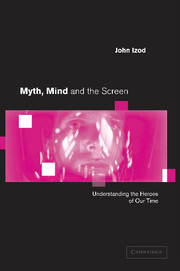Book contents
- Frontmatter
- Contents
- Acknowledgments
- Introduction
- 1 Jungian theory, textual analysis and audience play
- 2 Archetypal images: signification and the psyche
- 3 Archetypal images: symbols and the cultural unconscious
- 4 The Piano, the animus and colonial experience
- 5 The pop star as icon
- 6 The quest of a female hero: The Silence of the Lambs
- 7 Television sport and the sacrificial hero
- 8 The polycentred self: The Passion of Darkly Noon
- 9 Haunted: searching for the whole self
- 10 Transforming the final ghost: the god within
- Conclusion
- Filmography
- Glossary of Jungian and related terms
- References
- Index
Conclusion
Published online by Cambridge University Press: 22 September 2009
- Frontmatter
- Contents
- Acknowledgments
- Introduction
- 1 Jungian theory, textual analysis and audience play
- 2 Archetypal images: signification and the psyche
- 3 Archetypal images: symbols and the cultural unconscious
- 4 The Piano, the animus and colonial experience
- 5 The pop star as icon
- 6 The quest of a female hero: The Silence of the Lambs
- 7 Television sport and the sacrificial hero
- 8 The polycentred self: The Passion of Darkly Noon
- 9 Haunted: searching for the whole self
- 10 Transforming the final ghost: the god within
- Conclusion
- Filmography
- Glossary of Jungian and related terms
- References
- Index
Summary
The publication of Krin and Glen O. Gabbard's Psychiatry and the Cinema (1987) started a debate between screen analysts and clinicians about the therapeutic potential of movies. As we saw in Chapter 1, the Gabbards believe films give spectators the opportunity through role- and symbol-play (buttressed by their sense of an emotional connection with other fans) to gain mastery over their terrors and repressions. My own book supports this case and goes further in suggesting that screen fictions can stimulate and support individuation as part of the positive processes of maturation. As clinicians, however, Christoph Hering and David Hewison take up more sceptical positions, justified by their work with patients who have had extreme difficulty in accommodating what Hering terms their internal scenario of terror (Hering 1994: 403). And Hewison refers to patients who, governed by their internal scenarios, force-read films to match their own psychological circumstances or to firm up an insecure sense of identity (Hewison 2000: 292–3).
Hering focuses on the Alien films, applying object-relations theory to the presumed esponse of spectators to the monster. Describing the Alien as absolute evil devoid of any mitigating features, he agrees with the Gabbards that in Kleinian terms, given the immense horror it generates, it gathers around itself certain split-off facets of the spectator's personality. These embody aggressive tendencies and anxieties imperfectly repressed from infancy about nurturing figures who turn hostile.
- Type
- Chapter
- Information
- Myth, Mind and the ScreenUnderstanding the Heroes of our Time, pp. 204 - 208Publisher: Cambridge University PressPrint publication year: 2001



